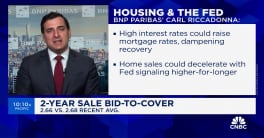Economists say the reported 1.9% GDP growth for the second quarter of 2008 was boosted by a 1.5% increase in consumption and a 2.4% gain in net exports. The figure was lower than expectations, however, as inventories saw a sharp reduction.
Aside from the headline, the big news came from revisions to the previous two quarters. GDP in the final quarter of 2007 was revised down to show the economy shrank by 0.2% in the quarter, down from an originally reported 0.6% gain. In addition, first-quarter growth came in at 0.9% from 1.0%, according to the Bureau of Economic Analysis.
Ian Shepherdson, chief U.S. economist at HFE, called the Q2 report "soft" and said to expect worse to come in the coming quarters. He said the major surprise was an "inexplicably massive" $62.2 billion drop in inventories, which accounted for a 1.9 percentage point subtraction from the headline.
He noted that final sales were stronger than expected with a 3.9% advance, which he attributed to a huge but "unsustainable" 2.4% gain in foreign trade.
Real exports of goods and services continued to grow significantly with a 9.2% gain in Q2, compared with a 5.1% rise in Q1. Real imports of goods and services decreased 6.6%, compared with a decrease of 0.8% in Q1.
Paul Ashworth, senior U.S. economist at Capital Economics, said the report is "pretty disappointing" given that the Treasury pumped $91 billion into the economy through the fiscal stimulus package in Q2. Going forward, he expects the economy to deteriorate further.
"With the boost from the tax rebates now fading, lower interest rates having no impact, and signs emerging that overseas demand is weakening, we expect the economy to contract outright in the second half of this year," he said.
Consumption rose 1.5% in the quarter. Shepherdson said that had it not been for the tax rebates, that figure may have been negative.
Millan Mulraine from TD Securities added that the contribution from personal spending was "massive," noting that it accounted for 1.08 percentage points of the 1.9% headline figure.
Real nonresidential fixed investment increased 2.3% in the second quarter, compared with an increase of 2.4% in the first. Nonresidential structures advanced 14.4% in Q2, compared with an increase of 8.6% in Q1, while real residential fixed investment decreased 15.6%, a slower decline from Q1's 25.1% decline.
"It's great that homebuilding was less of a drag on the overall economy, but with construction activity still plummeting at a double-digit rate it would be hard to conclude that housing is near bottom," said Ashworth.
The report includes revisions to the prior three years of data. For 2004-2007, real GDP grew at an average annual rate of 2.6%, one-tenth less than in the previously published estimates.
Real gross domestic product is the output of goods and services produced by labour and property located in the United States. The 1.9% advance represents growth from the first quarter to the second quarter, according to the advance estimates. The second quarter "preliminary" estimates, based on more comprehensive data, will be released on Aug. 28, 2008.
By Patrick McGee and edited by Sarah Sussman







